Great rivalries are fine entertainment. Think Harley-Davidson and Indian. Triumph and BSA. Honda and Yamaha. Now imagine BMW and KTM . For the last couple of years, the not-so-little company from Mattighofen, Austria, has been bore sighting BMW with a raft of charismatic but still technically cutting-edge products. Once satisfied to dominate off-road racing and the dirt bike sales that goes with it, KTM has outgrown those constraints. It wants BMW bloodied.
If you need proof that the company in orange is ready and able to give BMW a rash or two, consider the 1290 Super Adventure. Based largely on the 1190 Adventure that debuted just two years ago, the 1290 refines its approach and takes dead aim at BMW's R1200GS Adventure. With the 1190 Adventure and its more dirt-biased 1190 Adventure R remaining in the lineup, the Super Adventure is free to go after a more luxury-oriented clientele.
KTM started with the basic 1190 Adventure package. From the frame to the rear bodywork, it carries over many pieces from the 1190. But much is new, including a much larger fairing and considerably taller adjustable windscreen, intended to provide comprehensively more weather protection for the rider and passenger. The screen is so tall that it sits just below the eye level of most riders. It can be adjusted 80mm vertically, and for shorter riders, the mounting brackets can be reversed to drop the screen by about 30mm while still maintaining the full range of adjustment. Horizontal slots in the clear screen join with a carefully calibrated gap between the rear of the screen and the surrounding bodywork to reduce turbulence.
A wider upper fairing flares out to join the other big news for the 1290 Super Adventure: fuel, lots of it. Where the 1190 Adventure carries 6.3 gallons, the SA’s vessel swells to carry 7.9, coincidentally the same as the BMW R1200GS Adventure. Extending the tank out and down jettisoned the 1190’s wing-like tip-over guards, so the SA gets tubular-steel bars instead.
From the mechanical to the electronic, then. With the 1290 Super Adventure, KTM’s Keihin-built ride-by-wire system returns, albeit with a number of new features. They include cruise control, activated by a trio of switches on the right cluster. There’s an on/off switch, and a resume/increase and set/decrease rocker. And while the 1290 retains the familiar four ride modes: Street, Sport, Rain, and Off-Road, there’s a new trick: When the electronics sense the rider has made an especially aggressive downshift, they hold the throttle plates open very slightly to assist the slipper clutch in preventing wheel lockup. As before, changing ride modes also alters the bike’s lean-angle-dependent traction control, with the most intervention in Rain, less in Street, even less in Sport, and permitting substantial wheelspin in Off-Road mode. Both the ride-mode-selected TC and the lean-angle-informed ABS can be switched off totally.
Wheelspin would be part of your daily experience without the electronics, too, thanks to the bigger engine in the Super Adventure. Compared to the 1190, the Super’s engine gains 3mm in bore and 2mm in stroke to displace 1,301cc, just like the crazy-fast 1290 Super Duke R. KTM didn’t just shoehorn the Super Duke’s engine, though; the Adventure’s crank has 2kg more flywheel mass–1 kg on the crank itself and 1kg on the alternator rotor—for better low-speed behavior. The heads are different, too, with smaller ports that work with milder camshafts to boost low-speed torque rather than match the Super Duke’s claimed 180 hp at the crank. KTM posts a boost of just 10 hp from the 1190, to 160 hp at the crank, but torque bloats from 93 to 105 pound-feet, almost 1,000 rpm lower in the rev range. The Super Adventure continues the refinements brought to the 1190 as part of KTM’s search for improved efficiency through reduced friction and more efficient combustion, which is why you’ll change four plugs instead of two when the time comes.
Noticing the dual-plug heads takes a practiced eye, but you’ll suspect something is different with the 1290’s suspension right away. Connectors sprout from the fork caps and there’s a new menu page on the multifunction display. Yes, this means the Super Adventure has semi-active suspension, KTM’s first application. In concept, the WP-built system is something of a mixture of Ducati’s Skyhook and BMW’s Dynamic ESA. Like the Ducati, the KTM uses a pair of accelerometers mounted on the chassis to read pitch changes and the frame’s response to bumps. But KTM also fits travel sensors so that the system can read the actual position of the suspension. The rear employs a no-touch Hall-effect sensor on the swingarm that should be resistant to contamination, while the fork gets a novel magnetic sliding potentiometer inside the left leg. To keep the sensor clean, that leg carries no damping cartridge, just the single, heavy-duty spring and an electric preload adjuster. The other leg carries a conventional cartridge fitted with an electromagnetic valve that can change damping in 10 milliseconds. Like the familiar BMW designs, the WP shock has an electromagnetic valve to alter both rebound and compression damping, plus an electric motor preload adjuster. Selected through the comprehensive—and now almost crowded—menu system on the sub display, four load settings alter front and rear spring preload according to rider preference. (It is not automatic. The rider has to choose among solo, solo with baggage, two up, or two up with baggage.)
KTM’s programming starts the damping settings according to a baseline grid that is skewed through four rider-choosable schemes. Sport is the firmest, followed by Street, then Comfort, then Offroad. The system monitors both wheel travel—position in the stroke and calculated rate of change—and chassis accelerometer sensors to maintain predetermined levels of chassis movement and wheel freedom. When the system sees the bike heading out of range, it can very quickly alter the damping schemes softer or firmer to bring the chassis’ responses back into the desired range. But there’s more. Because the suspension computer is part of the bike’s total CAN-Bus, it reads brake-line pressure and throttle position, among other things, and can anticipate fork dive under braking or rear-end squat under acceleration. Moreover, this data are further refined by the lean-angle sensor; in a sense, the computer knows exactly what the bike is doing at any given time and can even anticipate what might happen next due to rider commands.
In a real sense, the KTM/WP semi-active suspension sounds far more daunting than it feels. In fact, compared to BMW’s D-ESA on the R1200GS, the 1290’s suspension options feel much more natural. It’s firm, as you’d expect from KTM, but never harsh, and the obvious alterations from the base map are progressive almost to the point of being subtle. Moreover, the difference in reactions from the firmest to the softest settings is smaller than you’d find on a BMW. Grab a handful of the Brembo radial-mount front brakes, which are superbike powerful, and the Super hunkers down for a rapid, straight stop with minimal fork dive and little sensation of the rear rising. Unexpectedly, the Sport mode actually allows a little more dive under braking to preserve steering feel during trail-braking maneuvers; the Street mode attempts to keep the bike much more level, and does. It also helps that KTM’s combined ABS braking system applies a discernible but not excessive amount of rear brake when you squeeze just the fronts. (It is not linked rear-to-front.) You can choose to turn the ABS off completely, but there’s also the Offroad mode that allows increased front-wheel slip and total rear-wheel lockup.
On the generally smooth roads on the Grand Canary Island, where the press launch was held, the semi-active suspension worked very well. Ride motions over small bumps were excellent, while overall chassis stability could hardly be questioned. Increasing the Load setting to rider+baggage, in effect increasing only rear preload, stopped the standard centerstand from smooching the pavement.
Otherwise, the Super Adventure ate the serpentine inland roads for breakfast, lunch, and dinner. It’s what happens when you have thrust on call from any rpm beyond the starter motor’s. Serious thrust. A section of road that could have been run in second and third gears could be comprehensively thrashed in third or fourth, allowing the 1290 engine to lug down to 2,000 rpm for the slower corners. From there, whack open the throttle and the bike pulls ahead, moderately at first but then with increasing urgency as the revs rise and the howl from the airbox stands the hair on your arms at attention. Because the lean-angle TC won’t allow the engine to unleash full torque when you’re leaned over, it becomes a matter of trail-braking to the apex, holding gentle bar pressure to maintain the line, and then whacking the throttle open. The Super Adventure surges ahead, tail wiggling seductively, TC light flashing on the tach face, and a huge smile on yours. Few bikes with this kind of easy speed put the power down so easily. No doubt the extra heft over a Super Duke and the missing 20 hp make it seem less frantic, but it’s still a huge thrill and totally in line with the bike’s “luxury adventure” mandate.
In KTM’s thinking, playing tag with sportbikes is just one part of the equation. The other involves long-range capability and comfort, which is why you get standard cruise control, new seats with standard heating and much improved padding, standard heated grips, and better wind protection. Overall, the new windscreen works well, though it works best when the upper edge is fairly close to the rider’s line of sight. Lower and turbulence increases noticeably, though it’s never aggravating. In the upper third of the range, you’ll find a calm, fairly quiet pocket of still air to hide in. Because the tank is wider than the 1190’s, you’ll have better lower-body protection, and your fists are shielded by standard, all-plastic hand guards.
Riders in warmer climates will appreciate the extensive efforts KTM’s engineering staff took to reduce heat on the rider. You can easily see the new insulation on the rear header pipe, and it’s effective. But so too are new ducts beneath the fuel tank that help direct hot radiator outflow away from the rider and even have separate paths to make sure the rider doesn’t get a kneecap full of BTUs when the radiator fan comes on. Finally, a small panel just beneath the two-position-adjustable seat helps keep hot air convecting off the engine from singeing the rider’s inner thighs.
From an ergonomic standpoint, the Super Adventure hits the bull’s eye. It doesn’t feel quite as massive as the GS Adventure, though the seat height is still an impressive 33.9 inches in the lower slot (34.5 inches in the higher position). You’ll find ample legroom and a comfortable reach to the aluminum “fat” handlebar, which isn’t quite as mirror-bangingly wide as a GS’s. A huge improvement over the old, the 1290’s seat is a welcoming perch that suggests draining that big tank in one sitting should be easy work.
One cool feature saved for last, then. Where BMW uses a steerable reflector in the K1600 series to provide lighting that sees into corners, KTM has a simpler approach. Two LED arrays live just inboard of the radiator shroud. Based on info from the lean-angle sensor, the first set of three segments lights with a lean angle of 10 degrees; the next at 20 degrees, and all three at 30 degrees of lean. They are aimed higher and further from the bike’s long axis as they light up. Unfortunately, we only rode during the daylight, but this seems to be a simple, effective means of improving headlight efficacy without undue complexity.
So, let’s look at the similarities between the 1290 Super Adventure and BMW’s R1200GS Adventure, the machine most in the KTM’s sights. Modern, liquid-cooled twin-cylinder engine. Check, though the KTM’s is bigger. Semi-active suspension. Check. Heated contact points for the rider. Check, though the BMW doesn’t have a heated seat except as an option. The latest in engine-control electronics. Check. Fuel to go 300-plus miles on a tank. Check. Adjustable ergonomics. Check. If you’re humming “everything you can do I can do better,” you get the idea.
Final line item: price. Here, KTM holds the advantage. For the US market, the 1290 SA comes with plastic-frame/alloy-clad hard saddlebags with a combined capacity of 73 liters. It already has all the other features baked in, from the semi-active suspension to KTM’s version of a hill-holder feature that keeps the brakes applied so you can drive off an incline without drama. All for $20,499. A BMW R1200GS Adventure starts at $18,495 but quickly gets above $20K with the options needed to match the KTM. Then add luggage. Our best guess is that the KTM will be around $4,000 less expensive when comparably equipped.
In the corporate rivalry that has KTM trying to vanquish one of BMW’s best loved, longest developed, and inherently good bikes there is more than mere entertainment value. There are, and will be, some truly great motorcycles.












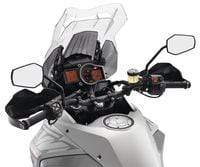


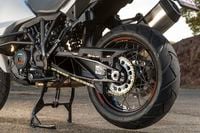
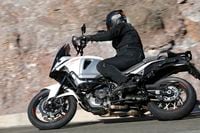

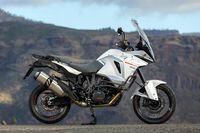
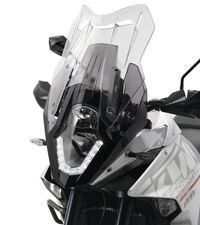

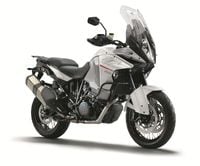

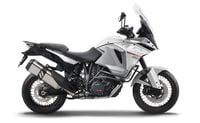
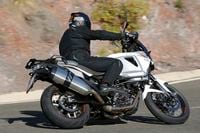
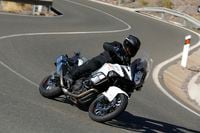
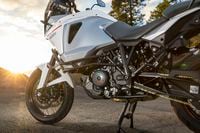
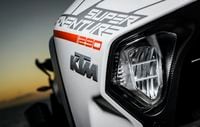
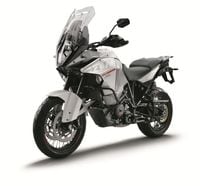
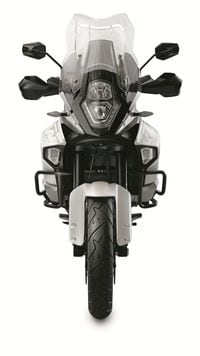
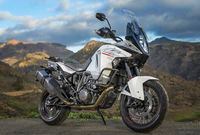
/cloudfront-us-east-1.images.arcpublishing.com/octane/7GJYDUIPXRGMTMQKN6ONYOLBOU.jpg)
/cloudfront-us-east-1.images.arcpublishing.com/octane/MUQLOVLL2ZDGFH25ILABNBXKTI.jpg)
/cloudfront-us-east-1.images.arcpublishing.com/octane/TNOU5DNE2BC57MFPMGN2EIDXAM.jpg)
/cloudfront-us-east-1.images.arcpublishing.com/octane/GTCXACQGJ5HAPDTGWUQKDEH44E.jpg)
/cloudfront-us-east-1.images.arcpublishing.com/octane/S35YGSEMEZB4BLTDJTSZPF4GLA.jpg)
/cloudfront-us-east-1.images.arcpublishing.com/octane/5UOT6HPX2JFMRJAX6EH45AR4MQ.jpg)
/cloudfront-us-east-1.images.arcpublishing.com/octane/OKWOJWAKP5EP3OACCRRWPCIX2Q.jpg)
/cloudfront-us-east-1.images.arcpublishing.com/octane/2WF3SCE3NFBQXLDNJM7KMXA45E.jpg)
/cloudfront-us-east-1.images.arcpublishing.com/octane/G4MG6OUCJNBSHIS2MVVOTPX65E.jpg)
/cloudfront-us-east-1.images.arcpublishing.com/octane/IIGGWFOTOJGB7DB6DGBXCCMTDY.jpg)
/cloudfront-us-east-1.images.arcpublishing.com/octane/QSTCM6AVEZA5JJBUXNIQ3DSOF4.jpg)
/cloudfront-us-east-1.images.arcpublishing.com/octane/U4I7G625B5DMLF2DVIJDFZVV6M.jpg)
/cloudfront-us-east-1.images.arcpublishing.com/octane/B6XD6LS6IVCQPIU6HXDJSM3FHY.jpg)
/cloudfront-us-east-1.images.arcpublishing.com/octane/ICL63FEDDRDTTMINYICCEYGMDA.jpg)
/cloudfront-us-east-1.images.arcpublishing.com/octane/FCGZHQXRBZFLBAPC5SDIQLVF4I.jpg)
/cloudfront-us-east-1.images.arcpublishing.com/octane/WNOB6LDOIFFHJKPSVIWDYUGOPM.jpg)

/cloudfront-us-east-1.images.arcpublishing.com/octane/X33NU3E525ECRHXLNUJN2FTRKI.jpg)
/cloudfront-us-east-1.images.arcpublishing.com/octane/6KKT5NNL2JAVBOXMZYS5ZO76YA.jpg)
/cloudfront-us-east-1.images.arcpublishing.com/octane/J5RKG5O455GMPGQRF2OG6LRT7A.jpg)
/cloudfront-us-east-1.images.arcpublishing.com/octane/GX2CIZKQVRH2TATDM26KFG2DAE.jpg)
/cloudfront-us-east-1.images.arcpublishing.com/octane/ZWIDYSAKQZHD5BHREMQILXJCGM.jpg)
/cloudfront-us-east-1.images.arcpublishing.com/octane/CYUHJZCTSJCH3MRAQEIKXK7SCQ.jpg)
/cloudfront-us-east-1.images.arcpublishing.com/octane/LKOFINY56FCXJCANJ5M7ZDQUBY.jpg)